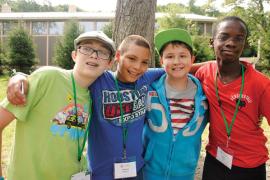Color television was invented in the early 1950s, and in the mid-tolate 1960s, my family didn't have one yet. My parents had seven children and were committed to putting us all through private elementary and high school — so our big black-and-white console TV seemed just fine to them. We had that black-and-white TV for a long time. And I thought we would probably never (in my lifetime) own a color television because they were so expensive. We had lived in a black-and-white world for so long that having a true multicolored television viewing experience seemed virtually impossible.
Then one day my family got our first color TV. As with our family, it took time for the entire country to convert to color. It wasn't easy for everyone to make the shift, even though the price of color televisions came down tremendously. And slow as it was, what that transition from black and white to color showed me was that the possibilities are endless. Today a multicolored television experience is readily available to everyone. Black-and-white televisions aren't even made anymore. It has surpassed my wildest imagination. Color is everywhere: on my phone, on the big screen, my computer — I can even get it on my wrist.
While television has evolved to include the spectrum of color, we are still struggling to make that a reality in our everyday experience. Sometimes it feels as if our current world has become more polarized and divisive than ever. Many of us are finding ourselves back in what feels like a monochromatic existence, particularly when communicating with others across cultures and even lifestyles. It has become progressively challenging, especially when our cultures, views, beliefs, and backgrounds are different. It is easy to get stuck, get discouraged, and forget where we started and how far we've come.
So how do we change the current narrative? Where do we start? Well, in the words of one of the greatest scientists of all time, Albert Einstein, "We can't solve problems at the same level of awareness from which they originated." Something within us has to shift. We have to approach the challenge in a different way to gain a different perspective — bring new ideas to the table and be unafraid to try something new, to fail, and start again.
When I look back at my family's journey from black-and-white television to color, it wasn't always smooth sailing. There were many different models before we got to where we are today. I remember one time, back when we didn't have a color TV, my dad came home with what he thought was the solution to all of our nagging — a technicolored film which he placed over our black-and-white TV screen. At first we were excited and thought it was a wonderful hack, but we soon realized that not every show we watched should have a blue sky, reddish-orange middle, and green grass. Daddy had tried, but we still wanted a real color TV.
To achieve the miraculous color television, it took the collaboration of scientists from all over the world — creating a fusion of shared ideas, visions, and viewpoints — imagining and creating a reality that had never existed before. They had to look at the challenge from a different angle and change their approach to it. In its most basic form, scientists were able to create a color broadcast by fusing together three monochrome images — one each in the three colors of red, green, and blue (RGB). When these three separate colors are displayed together in rapid succession, they give us the color image we see even today. The colors work together to create a picture that wouldn't be possible without each color showing up in its fullness.
A monochromatic view distorts reality and narrows our perception. We need a new way of seeing each other. We need a place where we can explore, showing up in our full, vibrant color with all the things that make us unique. That is why the world needs camp. We can't even imagine what incredible synergetic realities will be created. And just think of all of the things we are missing out on by not seeing and experiencing our lives in the richness of full color.
What I love about camp is that it requires us to be nimble (like scientists), to grow, try new things, be curious, and change our perspectives, all while having fun in a supportive environment. In a safe setting we get to practice being ourselves while interacting with people from different places in the raw — without makeup, our best clothes, or our hair perfectly combed. We may look a mess, and yet we feel amazing because we are creating a different version of ourselves from the inside out. Camp is the perfect laboratory for us to experiment and create a multicolored alternate reality where fear and prejudice are just not prevalent. It really is the perfect environment to change our individual and collective narratives.
Camp is a place where you are encouraged to bring your unique gifts and find and celebrate all that is uniquely you. If we are to create something different, our ideas and experiences have to be different as well — which means we have to be willing to include and be included. We have to be willing to stay engaged like any good scientist. It means that creating a truly multicolored camp experience will be complicated and complex, but the benefits will outweigh any challenges we encounter along the way if we just keep envisioning a reality that we know someday will be common place, mainstream, and easily accessible to everyone.
Yes, we are working with considerable injustice, privilege, prejudice, anger, sadness, and fear — many polarizing black-and-white issues. But all great minds love a complex problem to solve. All that is required is time, different perspectives, vision, creativity, respect for one another, and the willingness to see it through. We can figure it out — we are camp professionals for goodness sake! We thrive in the messy and unpredictable. We love to roll up our sleeves and make things happen. We just have to continue to engage. I believe camp is an incredible place for us to figure out this new and improved multicolored living experience.
Camp has the potential of creating a multicultural reality that the world will someday mirror. It has within it the answer to much of what ails us as a society. It holds within it all the lessons and wisdom that we need to heal wounds of the past, just as the original black-and-white television was the inspiration for the improved color version. And it is still being improved and the spectrum of experience continues to transform lives. The power of color television has made the stories we see more real. Camp could have that same affect by shifting our individual narratives and the stories we tell about ourselves and others.
We have to engage all of our natural scientists. If we pay attention, we will see that many of our children and young people, in general, are ready and waiting with their proverbial lab coats already on. They are leading the way to help us widen our circles — they know how to share and engage. There are no secrets; everything is up for debate, evaluation, and discussion — to be liked, shared, and commented on.
Our young people are creating a world that is very different from the one our parents and their parents lived in. Everything is documented through videos, SnapChat, Facebook, Twitter, Instagram, and so on. You never have to wonder what is being thought or felt — just check Vine. Sharing creates a transparency that disarms fear, because the world is a different place when you can have connections with anyone in almost any part of the world.
Youth are pushing against the status quo and challenging comfort zones. They're imagining a different reality that is breaking down cultural barriers, limited thinking, and injustice. They have figured out that we often push against the things we do not understand. But the more we see, the more we know, and the more we gain the capacity to understand.
If we want to see and experience a new reality, we have to cultivate the natural scientist in us all and include everyone in our social experiment. We have to imagine the world we want to see, and then just like scientists, work together with tenacity and vigor to create it. We know that it is possible, because in our camp laboratories we are experimenting, experiencing, and figuring it out. We are adjusting the contrasts and realizing that as we increase the contrasts, it sharpens what we see and experience, giving us a much clearer world view.
Camp feels good, it's good for us, and it is good for the world. No matter how many times we go to camp, each experience is guaranteed to be magical and unique. That's what keeps us coming back.
As I look to the future, I can only imagine that when our children's grandchildren look back on our time on this planet, they will scrunch up their faces in disbelief (just as my son did when I shared with him that televisions used to only be in black and white) that our culture was separated into black and white because their world and experience will be so multicolored, inclusive, and cross-culturally agile.
I believe camp will be a big part of this evolution. We are all scientists, and our gifts, perspectives, passions, humor, and vision are needed. We have to envision a world that doesn't quite exist and colorize and cultivate it into being. That is why camp has to include you, me, and everybody else.
Niambi Jaha-Echols is a wife, mother, author, social entrepreneur, professional educator, cultural agility strategist, and nationally recognized life empowerment and transformation advocate. She is the founder of The Butterfly Movement (thebutterflymovement.com), where she utilizes the symbolism of the caterpillar/ butterfly metamorphosis to foster emotional and spiritual transformation. Niambi is currently serving on the American Camp Association's National Board, is a faculty member of Expert Online Training, and is a professional advisor to graduate students at DePaul University's School for New Learning (niambijaha.com).
Photo courtesy of Camp Meriwether, Girl Scouts of Greater Atlanta, Luthersville, Georgia.



